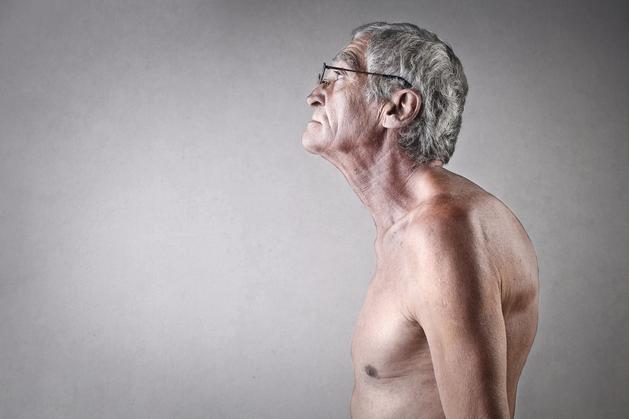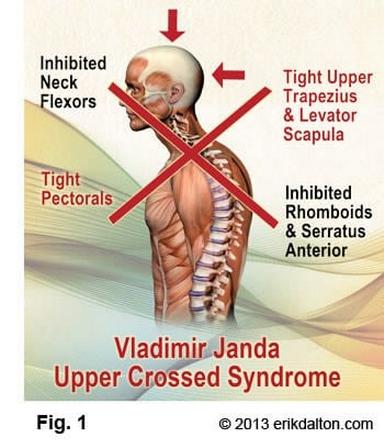Upper Cross Syndrome

As a kid you may have wondered what was wrong with the Hunchback of Notre Dame’s back.
The rounded shoulders and protruding upper vertebrae. The head in front of Quasimodo’s body. The curved neck and back. If you thought, “that must hurt,” you’re not far from the truth!
This condition has a name: UPPER CROSS or UPPER CROSSED SYNDROME (UCS).
You may have never heard the term before, but you’ve likely seen it before in real people, not just cartoons.
Who has Upper Cross Syndrome?
The elderly tend to develop upper cross syndrome. But, it’s also common in those of us who spend a LOT of time typing or working hunched over at a desk. Even some athletes will develop this condition, especially swimmers and weightlifters. These athletes tend to overuse the muscles in the neck, shoulders, and upper back which can lead to UCS..
Actually, it is a common postural problem of both young and old.

What Is Upper Cross Syndrome?
When the mid-back muscles (serratus and lower trapezius) become very weak, the pectoral and neck muscles tighten. This eventually leads to pain which may be throughout the upper body. You may experience shoulder pain and neck pain, as well as a reduced range of motion.
UCS is a muscle imbalance that is usually initiated through poor posture (think: hunched posture) which leads to tight chest muscles (pectorals and neck muscles). And, again, the mid-back muscles weaken and lengthen. This muscle dysfunction will also cause joint dysfunction of the vertebrae.
What Causes Upper Cross Syndrome?
Things that facilitate poor posture and can leave you at risk for UCS:
- Sitting for Extended Periods of Time
- Long hours at a Computer
- Using a Smartphone (lower than eye-level)
- Poor Sleeping Habits
- Driving Stress
Why is it Called Upper CROSS Syndrome?

The tight muscles are along one line and the weak muscles along another as seen in the figure above. The pectorals, traps, and levator scapula are tight and short, and they inhibit the neck flexors and mid-back muscles (rhomboids and serratus anterior) which become weak and lengthened.
This imbalance causes the spine to pull forward. This significantly increases the amount of stress on the supporting muscles which leads to more pain.
What are the Symptoms of Upper Crossed Syndrome?
- Rounded, hunched shoulders
- Neck and head crane forward
- Spine curving inward near the neck
- Spine curving outward in upper back and shoulder area
This is what it looks like.
How Does It Feel?
All of these imbalanced muscles stress the surrounding muscles, bones, tendons, and joints. Many people develop symptoms like these::
- Chest pain and tightness
- Pain in the upper back, especially the shoulders
- Headaches
- Neck pain or strain in the back of the neck
- Numbness, tingling, and pain in the upper arms
- Difficulty sitting, reading, watching television, or driving for long periods of time
- Restricted range of motion in the neck or shoulders
UCS can lead to chronic back pain. It can reduce range of motion. For active athletes it can lessen their mobility.
If left untreated it may cause damage to the spine from continual pressure on the front of the vertebrae. You don’t want to leave it untreated.
A Good Plan
Treatment for UCS should be a multi-pronged approach.
The tight muscles and poor posture that have led to upper cross syndrome can often cause your joints to become misaligned. Chiropractic adjustments can help to realign these joints, thereby increasing the range of motion in the affected areas.
In addition to this, an adjustment also usually stretches and relaxes the shortened muscles.
Manual therapy can also address muscular adhesions and trigger points which increases flexibility.
Finally, we design a program that helps you stretch the tight musculature and strengthen the weak muscles.
To Get You Started
One of the first areas to address with stretching is the pectoral muscles. Here are four stretches to try at home. Go gently and see how you feel. If you feel pain, back off of the stretch.
Wall Stretch
- Stand against the outer corner of a room or up next to the frame of a doorway.
- Put your right hand up as if saying the Pledge of Allegiance. Bend the elbow at a 90-degree angle and place your forearm against the wall or doorframe. Keep your left side open to the room.
- Press into your right forearm as you lean your left side into the open space of the doorway to feel a stretch in your right pec. Hold 15 to 20 seconds and repeat on the other side.
Elbow Wrap Stretch
Hold a hand towel between the hands to make up the distance.
- Stand with both feet firmly planted.
- Bring your arms behind your back and clasp each hand onto the hand towel.
- Hold to feel a stretch for 20 to 30 seconds. Lift your collarbones and squeeze your shoulder blades together as you stretch.
Back Bend Stretch
- Stand and bring your hands to the back of your head. Point your elbows directly outward to the left and right of your head.
- Now, allow your head to fall back into your hands as you open your chest and squeeze your shoulder blades together. Hold for 20 to 30 seconds.
Lying Chest Stretch
Try this move carefully as it can give a deep stretch.
- Lie flat on your stomach on the floor. Reach your arms out to the sides to create a T shape with your body.
- Bring your left hand to your hip and slowly begin to roll to the right — leaving your right arm extended on the floor.
- Pause when you feel the stretch in the right pec and hold for about 20 seconds. Repeat on the left side.
Come See Us
Upper Cross Syndrome gets worse over time so do not delay getting treatment. If you are in pain and need help, please give us a call at 262.638.9999.
At Daniels Chiropractic we can get your spine back into its normal position and increase your mobility and flexibility. We will also design a custom stretching and exercise plan for you to practice at home.
We are committed to helping you feel, move, and live better. We want to help you get better. So, give us a call at 262.638.9999 to make an appointment.
Daniels Chiropractic Office
2609 Rapids Drive
Racine, WI 53404
Phone: 262.638.9999
Fax: 262.638.0742
